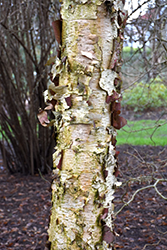It's all about ...
plants

Height: 60 feet
Spread: 40 feet
Sunlight:
![]()
![]()
Hardiness Zone: 5a
Other Names: Costata Birch
Description:
A distinctive large birch that features captivating white peeling bark with cinnamon colored undersides; broad ovoid to rounded form, low branched with a single trunk; a very attractive tree for a large landscape
Ornamental Features
Korean Birch has light green deciduous foliage on a tree with an oval habit of growth. The pointy leaves turn outstanding shades of yellow and in the fall. The peeling white bark and brick red branches are extremely showy and add significant winter interest.
Landscape Attributes
Korean Birch is a deciduous tree with a shapely oval form. Its relatively fine texture sets it apart from other landscape plants with less refined foliage.
This is a relatively low maintenance tree, and should only be pruned in summer after the leaves have fully developed, as it may 'bleed' sap if pruned in late winter or early spring. It is a good choice for attracting birds and squirrels to your yard. It has no significant negative characteristics.
Korean Birch is recommended for the following landscape applications;
- Accent
- Shade
Planting & Growing
Korean Birch will grow to be about 60 feet tall at maturity, with a spread of 40 feet. It has a low canopy with a typical clearance of 5 feet from the ground, and should not be planted underneath power lines. It grows at a medium rate, and under ideal conditions can be expected to live for 60 years or more.
This tree does best in full sun to partial shade. It prefers to grow in average to moist conditions, and shouldn't be allowed to dry out. This plant will benefit from an application of bonemeal and/or mycorrhizal fertilizer at the time of planting. It is not particular as to soil type or pH. It is somewhat tolerant of urban pollution. This species is not originally from North America.
This plant is not reliably hardy in our region, and certain restrictions may apply; contact the store for more information.
